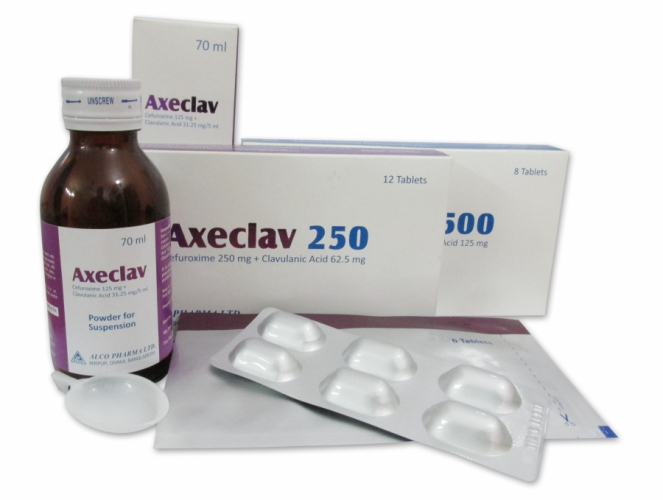ঔষধের বিস্তারিত বা বিকল্প ঔষধ জানতে ঔষধের নাম দিয়ে সার্চ দিন। যেমন- Napa বা Alatrol বা Amodis
Axeclav 500mg+125mg
TabletCefuroxime Axetil + Clavulanic Acid
Alco Pharma
Other Strength:
- Axeclav 250mg+62.5mg
Alternative:
- Furotil Plus 500mg+125mg
- Clavurox 500mg+125mg
- Cerox CV 500mg+125mg
- Xiclav 500mg+125mg
- Claviator-CV 500mg+125mg
- Axim CV 500mg+125mg
- Benkill CV 500mg+125mg
- Cefotil Plus 500mg+125mg
- Famiclav 500mg+125mg
- Turboclav 500mg+125mg
- Furoclav 500mg+125mg

Axeclav
Description:
Cefuroxime is one of the bactericidal second generation cephalosporin antibiotics, which is active against a wide range of Gram-positive and Gram-negative susceptible organisms including many beta-lactamase producing strains. Clavulanic acid has a similar structure to the β-lactam antibiotics but binds irreversibly to the β-lactamase enzymes.
The presence of clavulanic acid in Axeclav formulations protects Cefuroxime from degradation by beta-lactamase enzymes and effectively extends the antibacterial spectrum of Cefuroxime to include many bacteria normally resistant to Cefuroxime and other cephalosporins.
Composition:
Axeclav 125: Each film coated tablet contains Cefuroxime 125 mg as Cefuroxime Axetil USP and Clavulanic Acid 31.25 mg as diluted Potassium Clavulanate BP.
Axeclav 250: Each film coated tablet contains Cefuroxime 250 mg as Cefuroxime Axetil USP and Clavulanic Acid 62.5 mg as diluted Potassium Clavulanate BP.
Axeclav 500: Each film coated tablet contains Cefuroxime 500 mg as Cefuroxime Axetil USP and Clavulanic Acid 125 mg as diluted Potassium Clavulanate BP.
Axeclav 70 ml powder for suspension: After reconstitution, each 5 ml suspension contains Cefuroxime 125 mg as Cefuroxime Axetil USP and Clavulanic Acid 31.25 mg as diluted Potassium Clavulanate BP.
Dosage Guideline:
Infections
Dosages
Duration(Days)
Pharyngitis/tonsillitis
250 mg twice daily
5-10 days
Acute bacterial maxillary sinusitis
250 mg twice daily
10 days
Acute bacterial exacerbation of chronic bronchitis
250-500 mg twice daily
10 days
Secondary bacterial infections of acute bronchitis
250-500 mg twice daily
5-10 days
Community acquired pneumonia
250-500 mg twice daily
5-10 days
Uncomplicated skin & skin-structure infections
250-500 mg twice daily
10 days
MDR Typhoid fever:
500 mg twice daily
10-14 days
Uncomplicated urinary tract infection
250 mg twice daily
7-10 days
Uncomplicated gonorrhea
1000 mg once
Single dose
Lyme disease
500 mg twice daily
20 days
Paediatric patients (3 months to 12 years)
Infections
Dosages
Duration(Days)
Pharyngitis or Tonsillitis
20 mg/kg/day in two divided doses
5-10 days
Acute otitis media
30 mg/kg/day in two divided doses
10 days
Acute bacterial maxillary sinusitis
30 mg/kg/day in two divided doses
10 days
Community acquired pneumonia
30 mg/kg/day in two divided doses
5-10 days
MDR Typhoid fever
30 mg/kg/day in two divided doses
10-14 days
Uncomplicated skin & skin-structure infections
30 mg/kg/day in two divided doses
10 days
Uncomplicated urinary tract infection
20 mg/kg/day in two divided doses
7-10 days
Side Effects:
Generally Cefuroxime and Clavulanic acid are well tolerated. However, a few side effects like nausea, vomiting, diarrhea, abdominal discomfort or pain may occur. Rarely (<0.2%) renal dysfunction, anaphylaxis, angioedema, pruritus, rash and serum sickness like urticaria may appear.
Contraindication:
Patients with known allergy to cephalosporins & pseudomembranous colitis are contraindicated.
Drug Interaction:
Concomitant administration of probenecid with Axeclav increases the area under the serum concentration versus time curve by 50%. Drug that reduces gastric acidity may result in a lower bioavailability of Cefuroxime and tend to cancel the effect of postprandial absorption.
Use in Pregnancy & Lactation:
During pregnancy: While all antibiotics should be avoided in the first trimester if possible. However, Axeclav can be safely used in later pregnancy to treat urinary and other infections.
During lactation: Axeclav is excreted into the breast milk in small quantities. However, the possibility of sensitizing the infant should be kept in mind.
Over Dose:
Signs and symptoms: Overdosage of Axeclav can cause cerebral irritation leading to convulsions.
Management: Serum levels of Axeclav can be reduced by haemodialysis and peritoneal dialysis.
Precaution:
Axeclav should be given with care to patients receiving concurrent treatment with potent diuretics & who have history of colitis.
Therapeutic Class:
Anti-Infective
Dosage Form:
Tablet & PFS
Storage:
Axeclav tablet should be kept in a cool (15–30 °C) and dry place and protected from light.
Axeclav powder for suspension should be kept in a cool (below 250 C) and dry place and protected from light.
এই পাতাটি ১৯৪ বার দেখা হয়েছে
রাজডক কী?
ফ্রী সদস্য হোন Click Here
ডাক্তার হিসাবে যোগদান করতে Click Here
নার্স / টেকনোলজিস্ট হিসাবে যোগদান করতে Click Here
ফ্রী সদস্য হোন Click Here
ডাক্তার হিসাবে যোগদান করতে Click Here
নার্স / টেকনোলজিস্ট হিসাবে যোগদান করতে Click Here

